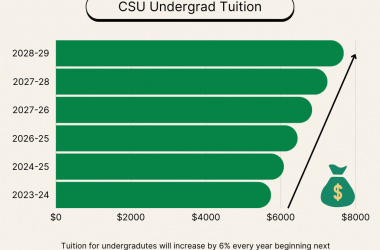Stakeholders of Long Beach and Los Angeles ports expressed concern with the declining cargo volumes and forecasts of expected competition over discretionary cargo.
These issues were discussed at the Cal State Long Beach Center for International Trade and Transportation’s 10th town hall meeting that took placed Wednesday evening at the Carpenter Performing Arts Center before a near-capacity crowd.
The meeting, titled “The Decade Ahead: Jobs, Cargo, Competition, and You,” focused on the economic recession’s effects on the ports.
Paul Bingham, managing director of global trade and transportation at IHS Global Insight — a forecasting and consulting company — was admittedly the bearer of bad news.
Bingham characterized the current state of the economy as “The Great Recession.”
“This quarter, the first quarter of 2009, is actually forecasted by our company to be the worst part of the recession,” Bingham said, during his 25-minute presentation. “What we saw last year wasn’t the worst of it; we’re still in it.”
With the recession felt on the global and domestic levels, port customers are seemingly in survival-mode, Bingham explained.
“There are many companies that may not be able to survive [the recession],” Bingham said. “There is tremendous pressure from their customers to minimize cost.”
Minimizing cost is what has many stakeholders worried that discretionary cargo — cargo that is moved through the port to non-local destinations — normally brought through the San Pedro Bay will be steered elsewhere in order to avoid fees.
“This past December, California passed the most aggressive and most expensive climate change plan in the world, on its own,” said Patty Senecal, director of the California Government Affairs for the International Warehouse Logistics Association.
“But what is the price of being first?” she said. “If we get this wrong, other states will gladly take our business.”
Senecal urged policymakers to take their time with new regulations and stressed getting it right the first time.
Ports in Tacoma and Seattle, Wash., will improve their rail access and port facilities to handle more inbound cargo traffic, according to a video presented at the meeting.
Briefly discussed at the meeting was the expansion of the Panama Canal that, by 2014, will allow large vessels currently only able dock on the West Coast to travel through the canal to East Coast ports.
Ports in Mexico and British Columbia also offer port customers an alternative to the San Pedro Bay.
Richard Steinke, executive director of the Port of Long Beach, expressed his concern, in the video presentation, that cargo from the trans-Pacific may not come through Southern California ports.
“That being said, cargo wants to come to Southern California,” Steinke said. “There’s a large captive consumer base; there’s great intermodal connections; good weather; very developed distribution and warehouse system.”




hey Union, nice coverage of the BLR in the 3/09 issue.
How can a newspaper be considered reliable if they can’t even spell the name of where they are correctly in the headline? I live in “Southern California” not “Souther California” Anybody need to buy a map at the forty-niner?